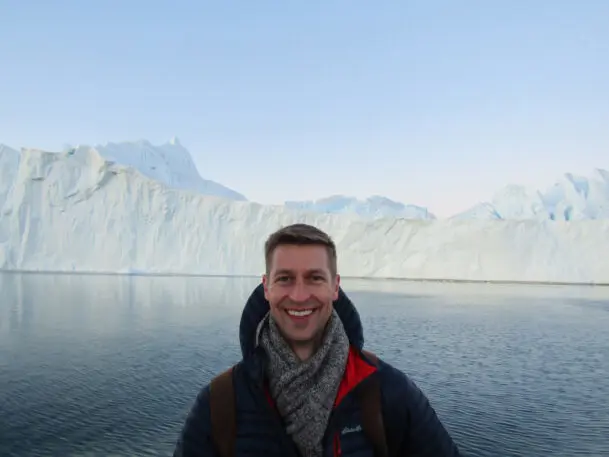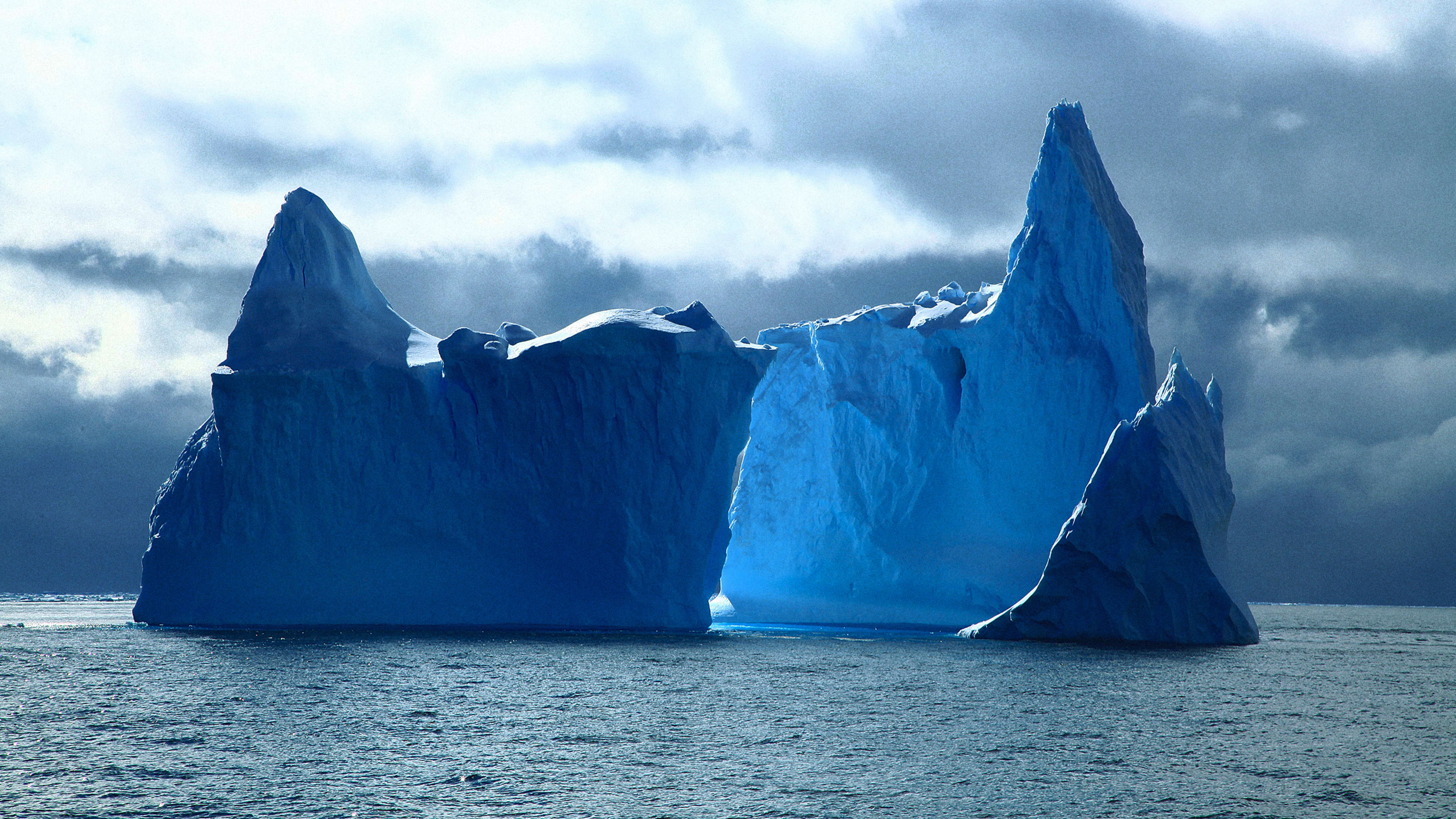In Chasing Icebergs, Matthew Birkhold introduces readers to a colorful cast of characters with wildly different ideas about how (and if) humans should use icebergs. Here he travels with Nick Sloane, a mariner on a mission to transport an iceberg from Antarctica to South Africa.
Nick Sloane may just be the visionary we need if iceberg towing is to become a reality. His desire to find a solution for the water crisis in Cape Town has convinced him the risk of seeming laughable is worth the reward of collecting these freshwater jewels.

Sloane was born in the British protectorate Northern Rhodesia, now Zambia, in 1961, and spent his youth sailing on the Indian Ocean. After becoming a master mariner licensed to captain ships of any size anywhere in the world, Sloane turned his attention to salvage operations. When a vessel goes down, whether an oil tanker, ocean liner, or container ship, Sloane knows how to recover it. He has worked across the globe, from Papua New Guinea to New York Harbor, in some of the harshest conditions imaginable: aboard crumbling ships sometimes on fire, often sinking, and spewing chemicals and oil. In 2013, he became famous for salvaging the wrecked Italian cruise ship Costa Concordia, which made headlines when it struck a rock off the coast of Tuscany and capsized, killing 33 people and causing roughly $2 billion in damage.
Salvaging a ship like the Costa Concordia, three football fields long and over 100,000 tons, requires extremely specialized knowledge and careful planning. Over 30 months, Sloane organized more than 500 people to get the job done. This required not just mastery of logistics and diplomacy, but also a keen intuition.
Now, Sloane’s gut tells him the future is in icebergs. He is ready to leverage his deep knowledge of the ocean, engineering expertise, and contacts throughout the maritime world to bring freshwater to the country. The first time I heard Sloane speak was in a YouTube video. Coming from someone else, the sentiments he shares would seem hackneyed. “You need to never give up on your dreams,” Sloane lilts in his languid accent, “go out and try. Whenever you have an opportunity, take it. And never give up, just keep on going.” Out of Sloane’s mouth, the words take on weighty importance. This is a man who has confronted extraordinary danger and lived to tell his tale. For good reason, Sloane is featured in a lot of inspirational materials. Nevertheless, Sloane and his competitors face a few obstacles when it comes to icebergs, including physics.
It doesn’t take a glaciologist to figure out that the biggest challenge of towing an iceberg from Newfoundland to the Canary Islands or from Antarctica to South Africa is that the ice will melt before it reaches its destination. Cape Town, for instance, is more than 2,000 miles from Antarctica and the water temperature in Table Bay can be 50 degrees Fahrenheit warmer than in the Southern Ocean. To understand the best way to solve the problem, it’s helpful to know a little bit about thermodynamics. For that, imagine an ice cube in a glass of water. Why does it melt? The answer is explained by the exchange of energy that occurs.
Ice and water, of course, are the same substance in different states. In a liquid state, water molecules bounce around. Warmer water has more kinetic energy than cooler water—think about boiling water compared to room-temperature water. At lower temperatures, those molecules slow down. Eventually, at 32 degrees Fahrenheit, the molecules have lost so much energy they are better able to stick together. They form stable hydrogen bonds, which expand into crystalline forms. The water freezes and becomes solid.
When an ice cube is plopped into a glass of water, energy is transferred. The faster-moving liquid water molecules hit the ice and lose energy. The stable hydrogen bonds, in turn, absorb energy. The water becomes a little cooler and the ice gets a bit warmer. If there is more water than ice, the ice molecules will eventually soak up enough energy that they get excited and break the bonds that hold them together. The ice, in other words, will melt. A similar process happens to the part of the ice cube floating above the water, since room-temperature air contains more kinetic energy than ice. As the molecules in the air collide with the ice, they cause it to melt. Like with water, a greater air temperature will result in more kinetic energy transferred to the ice and thus a faster melt rate.
If you wanted to melt the ice cube in your glass faster, you could try a few tricks. Blowing on the ice would bring additional air molecules into contact with the cube, transferring more energy to the ice. Swirling the water would also help. Since the water nearest the ice will be coldest as the cube melts, the conduction of energy will begin to slow. Stirring the glass would introduce warmer water with more kinetic energy to the ice, accelerating the melt rate compared to letting the ice sit in place.
Conversely, if you wanted to reduce the melt rate, you could add salt to the glass. Because salt water is denser than freshwater, it would sink to the bottom of the glass. This would leave the coldest water—the freshwater melted from the cube—at the top of the glass near the ice, slowing the energy transfer.
The same principles apply to dragging an iceberg to Cape Town or Fujairah. Whether or not an iceberg will make it to its destination depends not just on its size and the distance it will travel but also the water and air temperature, the amount of wind, the ocean currents through which it is pulled, the salinity of the water surrounding it, and the time the berg spends in transport. As roughnecks moving bergs away from oil rigs off the coast of Canada know, going fast is not an option. To minimize the deleterious effects of the energy transfer, there are two main strategies: protect the ice and capture such a large block of ice that it won’t matter if some or even most of it melts.

Many people familiar with icebergs are doubtful the physics can be overcome. Their incredulity is rooted in extensive hands-on experience. They have seen icebergs fall apart mid-tow. They know the amount of work required to wrangle the beasts. They know just how ephemeral these resources are. Such experience, however, may also limit their imagination. Icebergs can be unfathomably big and humankind possesses massive power. Skeptics of long-distance iceberg towing may just need to dream bigger.
Excerpted with permission from Chasing Icebergs: How Frozen Freshwater Can Save the Planet, by Matthew Birkhold.
Recognize your brand’s excellence by applying to this year’s Brands That Matter Awards before the early-rate deadline, May 3.
